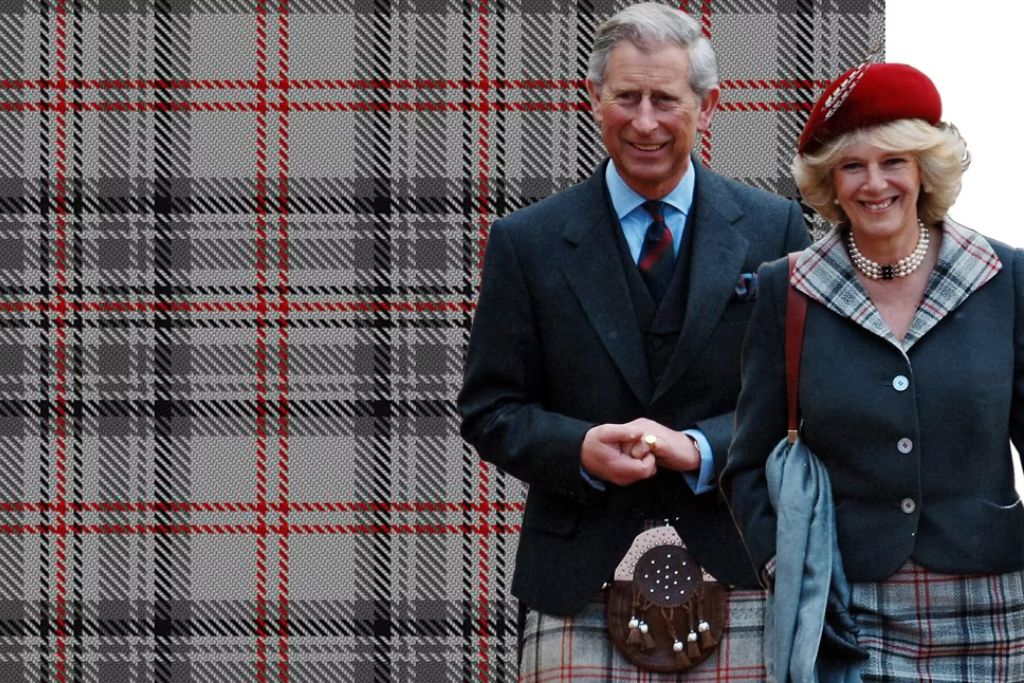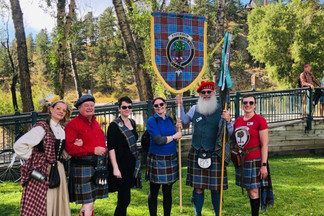Posted by Maris on 26th Jul 2023
Scottish Tartan: 17 Facts about Tartan starting with the Royal Family’s design
Patterns of interlocking stripes on clothing are known by many as “plaid,” but this is in fact tartan. The word ‘plaid’ actually originates from the Scottish Gaelic ‘plaide’ which means ‘blanket’, and it refers to Highland dress where such material was used to form a ‘kilt’ – a word connected to the Scots language.
Tartan has been dated back to 3000 BC in some parts of the world while the earliest known tartans in Scotland came in around the 3rd or 4th century, so why is it such a powerful Scottish symbol? It comes down to Scottish Highland culture and how after the Battle of Culloden in 1746 the British Government passed the Act of Proscription which forbade the use of tartan to suppress Scottish culture. This makes its prominence in Scotland today symbolically powerful when we reflect on its history.
As King Charles III’s coronation draws closer, here are 17 facts about tartan you (probably) never knew starting with the royal family’s relationship with the Scottish garb.
One of the most exclusive tartans ever made is the Balmoral, which dates from 1853. Designed by Queen Victoria’s husband Prince Albert. Featuring grey with red and black, the twisted black and white yarns are said to be reminiscent of the granite seen in Aberdeenshire’s Royal Deeside, where Balmoral is located. This tartan is one of few which can only be worn by members of the Royal family and the Queen’s personal piper with permission from the monarch.
1. Prince Albert (Queen Victoria’s husband) designed his own tartan

One of the most exclusive tartans ever made is the Balmoral, which dates from 1853. Designed by Queen Victoria’s husband Prince Albert. Featuring grey with red and black, the twisted black and white yarns are said to be reminiscent of the granite seen in Aberdeenshire’s Royal Deeside, where Balmoral is located. This tartan is one of few which can only be worn by members of the Royal family and the Queen’s personal piper with permission from the monarch.
Royal Stewart Tartan has long been known as the personal tartan of Queen Elizabeth II and the royal House of Stewart. However, during the 1970s the colours gained a significant alternative meaning as the preferred colours of the UK punk scene, who were keen to diminish the image of Victorian state power it presented by tearing it up and wearing it in unconventional ways.
Related Posts:
- 19 Fun And Interesting Facts About The Bagpipes You Might Not Know
- The 10 Most Common Scottish Surnames & Their Clan History
- SCOTTISH TARTAN – DETAILS EXPLAIN
2. The Royal Stewart Tartan was Queen Elizabeth II’s personal one

Royal Stewart Tartan has long been known as the personal tartan of Queen Elizabeth II and the royal House of Stewart. However, during the 1970s the colours gained a significant alternative meaning as the preferred colours of the UK punk scene, who were keen to diminish the image of Victorian state power it presented by tearing it up and wearing it in unconventional ways.
Diana Princess of Wales has her own Memorial Tartan, which is a pale blue and white design mated to heavily pronounced black and red grids. The “Princess Plaid” features the colours of the Union Jack and was created as a sympathetic tribute and variation of the Royal Stewart colours.
Tartan Plaid offers a special collection. Discover and shop now with 15% off code: TARTANBLOG15 (use code at check out)

3. A ‘tribute tartan’ exists for Princess Diana

Diana Princess of Wales has her own Memorial Tartan, which is a pale blue and white design mated to heavily pronounced black and red grids. The “Princess Plaid” features the colours of the Union Jack and was created as a sympathetic tribute and variation of the Royal Stewart colours.
April 6 is not just famous for being the date of Scotland’s independence via the Declaration of Arbroath in 1320 – it has also gained notoriety as Tartan Day throughout the northern hemisphere in particular. In the US in 2008, an annual April 6 Tartan Day was proclaimed by President George W Bush, in the photograph above you can see the late Sean Connery in attendance back in 2002.
4. Tartan Day falls on April 6

April 6 is not just famous for being the date of Scotland’s independence via the Declaration of Arbroath in 1320 – it has also gained notoriety as Tartan Day throughout the northern hemisphere in particular. In the US in 2008, an annual April 6 Tartan Day was proclaimed by President George W Bush, in the photograph above you can see the late Sean Connery in attendance back in 2002.
5. The Ogilvie tartan is the most ‘complex’ one

According to the official Scottish Register of Tartans, the most complex tartan to weave is the Ogilvie with approximately 96 colour changes. It dates back to 1812 and is also known as the Drummond of Strathallan tartan. Photo: Submitted
A tartan ribbon was the subject matter of the first ever colour photograph taken by James Clerk Maxwell in 1861. Maxwell was a Scottish physicist accredited for the classical theory of electromagnetic radiation, he was born in Edinburgh.
6. The first colour photograph is of a tartan ribbon

A tartan ribbon was the subject matter of the first ever colour photograph taken by James Clerk Maxwell in 1861. Maxwell was a Scottish physicist accredited for the classical theory of electromagnetic radiation, he was born in Edinburgh.
The first and only ever piece of tartan to be taken to the moon was the MacBean tartan. It was taken there back in 1969 by Alan Bean who was the fourth man to walk on the moon’s surface.
7. Tartan has been taken to the moon

The first and only ever piece of tartan to be taken to the moon was the MacBean tartan. It was taken there back in 1969 by Alan Bean who was the fourth man to walk on the moon’s surface.
Harris Tweed or “Clo Mor” (derived from the Scottish Gaelic for ‘Big Cloth’) is the only fabric in the world which its own Act of Parliament governs. The decree states that genuine Harris Tweed must be made from pure virgin wool which was dyed and spun in the Outer Hebrides of Scotland and handwoven at home by the weaver.
8. A tartan is the world’s only fabric to be protected by an Act of Parliament
Harris Tweed or “Clo Mor” (derived from the Scottish Gaelic for ‘Big Cloth’) is the only fabric in the world which its own Act of Parliament governs. The decree states that genuine Harris Tweed must be made from pure virgin wool which was dyed and spun in the Outer Hebrides of Scotland and handwoven at home by the weaver.
9. The origin of the word ‘tartan’ is unclear
The word “tartan” itself has been dated back to 1500 but its exact origins have not been definitively concluded. Some suspect it is connected to the Old French “tertaine” which refers to a type of cloth.
With an estimate of over 4,500 tartans in existence, new tartans can be registered with the Scottish Register of Tartans. The oldest tartan ever found in Scotland was found buried in a pottery jar in Falkirk and filled with Roman-era coins and was made of sheep’s wool.
10. The oldest tartan ever found in Scotland dates to 250 AD

With an estimate of over 4,500 tartans in existence, new tartans can be registered with the Scottish Register of Tartans. The oldest tartan ever found in Scotland was found buried in a pottery jar in Falkirk and filled with Roman-era coins and was made of sheep’s wool.
Kilts made of tartan come in different weights, with 16oz seen as heavy weight. Most tartans are available in 12 or 13oz (medium weight) categories, which are perfect for warmer climates. The lightest weights – 10oz – is usually only acceptable for tartan accessories such as scarves or neckerchiefs.
11. Tartan kilts come in many different weights
Kilts made of tartan come in different weights, with 16oz seen as heavy weight. Most tartans are available in 12 or 13oz (medium weight) categories, which are perfect for warmer climates. The lightest weights – 10oz – is usually only acceptable for tartan accessories such as scarves or neckerchiefs.
12. Almost every Canadian province has its own tartan

With the exception of Nunavut located in the North, every province and territory of Canada has its own official tartan.
13. The Braveheart movie has its own tartan
Braveheart, the mid-1990s Scottish historical epic starring Mel Gibson, had a tartan specifically designed for the film by Gordon Cavell of the Islay Woollen Mill and Charles Knode of the Shepperton Studios wardrobe department. The story goes that Knode sent Cavell a piece of clothing and asked him to create a tartan design from it that could also be used as a tweed.
Despite the proliferation of this trend, the presence of eagle feathers in a tartan wearer’s bonnet (hat) should only be permitted if the wearer in question is a clan chieftain. In a similar vein – to not cause any inattentive disrespect to Scotland’s historical garb – it is recommended that your kilt reach to the middle of your kneecap for the best fitment, regardless of tartan.
14. Eagle feathers on a tartan hat are for Clan Chieftains
Despite the proliferation of this trend, the presence of eagle feathers in a tartan wearer’s bonnet (hat) should only be permitted if the wearer in question is a clan chieftain. In a similar vein – to not cause any inattentive disrespect to Scotland’s historical garb – it is recommended that your kilt reach to the middle of your kneecap for the best fitment, regardless of tartan.
Irn Bru’s own tartan was originally designed in 1969 as the ‘Barr tartan’ and was updated in the 90’s with a redesign by Kinloch Anderson that saw its name changed to ‘Irn-Bru tartan’. It has since been registered with the Scottish Tartans Society.
15. Irn Bru has its very own tartan
Irn Bru’s own tartan was originally designed in 1969 as the ‘Barr tartan’ and was updated in the 90’s with a redesign by Kinloch Anderson that saw its name changed to ‘Irn-Bru tartan’. It has since been registered with the Scottish Tartans Society.
In Australia and New Zealand, you can find another international Tartan Day but this event is held on July 1 instead. This is to mark the anniversary of the repeal of the 1746 Act of Proscription that outlawed the wearing of tartan.
16. Other countries like Australia celebrate Tartan Day on July 1
In Australia and New Zealand, you can find another international Tartan Day but this event is held on July 1 instead. This is to mark the anniversary of the repeal of the 1746 Act of Proscription that outlawed the wearing of tartan.
17. Scotland’s most famous comic character also has his own tartan
One of Scotland’s oldest comic strip characters, Oor Wullie, received his very own specially-made tartan in 2010 to commemorate 75 years in print. His design, based on the Black Watch tartan, features silver-grey inspired by his bucket and yellow for the character’s golden hair.

